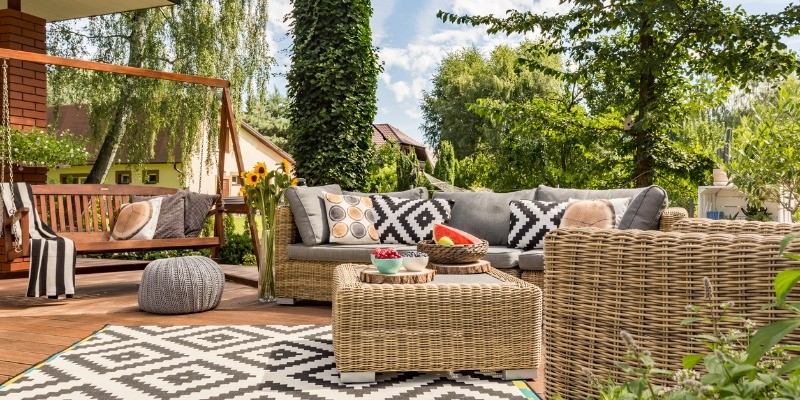Introduction:
Selecting the best material for outdoor furniture is crucial for ensuring durability, comfort, and aesthetics in outdoor spaces. With a wide range of materials available, each offering its own set of benefits and considerations, choosing the best material can be a daunting task. This comprehensive guide examines some of the best materials for outdoor furniture, considering factors such as durability, weather resistance, maintenance requirements, style options, and budget considerations.
Teak Wood:
Teak wood is widely regarded as one of the best materials for outdoor furniture due to its exceptional durability and natural resistance to rot, decay, insects, and moisture. Teak contains natural oils that protect it from the elements, making it well-suited for outdoor use in various climates. Additionally, teak wood has a beautiful appearance with a rich, golden hue that can complement a range of outdoor settings. While teak furniture may require periodic maintenance to preserve its appearance, such as regular cleaning and occasional resealing, its longevity and timeless appeal make it a popular choice for outdoor furniture enthusiasts.

Aluminum:
Aluminum is another excellent material for outdoor furniture, prized for its lightweight yet sturdy construction, rust resistance, and low maintenance requirements. Aluminum furniture is highly durable and can withstand exposure to the elements without rusting or corroding, making it ideal for outdoor use in humid or coastal environments. Additionally, aluminum furniture is available in a wide range of styles and finishes, from sleek and modern to traditional and ornate, allowing consumers to find options that suit their aesthetic preferences. With its durability, versatility, and ease of maintenance, aluminum outdoor furniture offers an attractive combination of performance and style.
All-Weather Wicker:
All-weather wicker, also known as synthetic resin wicker, is a popular choice for outdoor furniture due to its durability, weather resistance, and aesthetic appeal. Unlike natural wicker, which can deteriorate when exposed to moisture and sunlight, all-weather wicker is made from synthetic materials such as polyethylene or resin that are resistant to fading, cracking, and peeling. This makes it an ideal option for outdoor use in regions with harsh weather conditions. Additionally, all-weather wicker furniture often features aluminum frames for added stability and support, further enhancing its durability and longevity. With its classic look and modern performance, all-weather wicker furniture offers a stylish and practical solution for outdoor living spaces.
Powder-Coated Steel:
Powder-coated steel is a durable and cost-effective material option for outdoor furniture, known for its strength, stability, and resistance to rust and corrosion. Steel furniture is typically constructed with welded frames that provide sturdy support and stability, making it suitable for use in windy or high-traffic outdoor areas. The powder-coating finish adds an extra layer of protection against the elements, ensuring that steel furniture maintains its appearance and integrity over time. While steel furniture may require occasional touch-ups to address scratches or chips in the powder-coating, its affordability and durability make it a popular choice for budget-conscious consumers seeking reliable outdoor furniture options.
Polywood:
Polywood is a synthetic lumber made from recycled plastic materials, offering a durable and environmentally friendly alternative to traditional wood furniture. Polywood furniture is resistant to moisture, rot, insects, and UV rays, making it well-suited for outdoor use in all weather conditions. Additionally, polywood furniture requires minimal maintenance, as it does not need to painte, stained, or sealed like natural wood. Polywood furniture is available in a variety of colors and styles, allowing consumers to find options that complement their outdoor decor. With its eco-friendly design, durability, and low maintenance requirements, polywood furniture offers a sustainable and practical choice for outdoor living spaces.
Cast Aluminum:
Cast aluminum is a versatile and durable material option for outdoor furniture, prized for its strength, corrosion resistance, and intricate detailing. Cast aluminum furniture make by pouring molten aluminum into molds, allowing for intricate designs and decorative embellishments that mimic the look of wrought iron at a fraction of the weight. Cast aluminum furniture is highly durable and resistant to rust, making it suitable for outdoor use in various climates. Additionally, cast aluminum furniture is easy to maintain, requiring only occasional cleaning with soap and water to remove dirt and debris. With its classic elegance and enduring performance, cast aluminum furniture adds a touch of sophistication to outdoor living spaces.
Conclusion:
Choosing the best material for outdoor furniture involves considering factors such as durability, weather resistance, maintenance requirements, style options, and budget considerations. Teak wood, aluminum, all-weather wicker, powder-coated steel, polywood, and cast aluminum are among the top materials for outdoor furniture, each offering unique benefits and considerations. By understanding the characteristics of each material and assessing your specific needs and preferences, you can select outdoor furniture that enhances your outdoor living experience and withstands the elements for years to come.